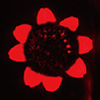| Oct 22, 2025 |
Researchers create a photochromic fluorescent system that performs optical neural computing and visual output in one step, cutting power use and complexity.
(Nanowerk News) The rapid growth of artificial intelligence and intelligent perception systems in fields such as edge computing, medical imaging, and security identification has placed increasing demands on information-processing hardware.
|
|
Conventional computing systems built on the von Neumann architecture face well-known bottlenecks: sensing, storage, processing, and display occur in separate units, causing frequent data transfers and high energy consumption. Optical neural networks (ONNs) have emerged as a promising alternative, offering high-speed parallelism and low latency.
|
|
Yet most optical computing platforms still rely on interference, diffraction, or phase modulation, and continue to depend on electronic display modules for output. This separation prevents full integration of computing and display functions. Moreover, conventional optical systems require analog-to-digital and digital-to-analog converters, adding complexity and power overhead.
|
|
A research team led by Professor Han Zhang and Assistant Professor Songrui Wei at Shenzhen University, in collaboration with the University of Hong Kong, the Southern University of Science and Technology, Pengcheng Laboratory, and other institutions, has introduced a new optical neural computing framework based on fluorescence matrix–vector multiplication (FMVM).
|
|
The study was published in Optica (“Fluorescence matrix–vector multiplication: realization of in-memory-display computing”).
|
|
The method brings together, at the material level, the programmability of photochromic compounds and the emissive capabilities of fluorescent molecules—combining optical weight programming, computation, and display within a single structure.
|
|
The FMVM system relies on the reversible photochromic pair spiropyran (SP) and merocyanine (MC). Under ultraviolet light, the non-fluorescent SP converts to fluorescent MC; under visible light, the process reverses. This reversible transformation endows the material with memory-like properties.
|
|
The team embedded SP molecules uniformly into a polymethyl methacrylate (MMA) matrix to create a thin film with finely tunable fluorescent responses. Using digital light processing (DLP) projection, ultraviolet patterns were written onto the film to define spatially programmable fluorescence intensities—effectively encoding optical weights such as those used in fingerprint recognition tasks.
|
|
During operation, ultraviolet light patterns representing input vectors illuminate the pre-programmed SP–MC film. The resulting fluorescence corresponds to the product of the inputs and weights, forming a visible output pattern that can be directly viewed or captured by a camera.
|
|
Because the entire process remains in the optical domain, the system eliminates the need for photoelectric converters or external display devices, achieving in-memory-display computing in a single step. The underlying photochromic effect provides high spatial resolution, rewritability, and stable nonvolatile storage. By adjusting UV intensity and exposure time, the researchers achieved continuous control over MC concentration, realizing 5-bit (32-level) fluorescence precision and a writing resolution of roughly 33 µm.
|
|
The fluorescence response time is under 10 ns, with a bandwidth above 100 MHz—suitable for high-speed computing. The written patterns remain stable in darkness and retain performance after multiple write–erase cycles.
|
|
To validate the system, the team constructed a fluorescence neural network capable of identifying fingerprints from three individuals and displaying their corresponding names. Both simulations and experiments produced consistent outputs, and post-processing of the fluorescence signals yielded clear, standardized letter patterns.
|
|
This work represents the first demonstration of a hardware neural network performing computation through fluorescence. It establishes an integrated optical platform that unites perception, memory, computation, and display. The approach offers a path toward compact, energy-efficient solutions for wearable devices, edge AI systems, optical security identification, and natural optical signal processing.
|
|
Compared with existing optical neural network architectures, FMVM provides several key benefits:
|
- No ADC/DAC modules – the entire process is optical, avoiding signal conversion losses.
- Low power operation – stored weights require no continuous energy supply.
- Parallel display output – multiple visible results can be produced simultaneously.
- Nonvolatile storage – weights can be written, erased, and retained over time.
- Material flexibility – the principle can extend to fluorescent materials such as quantum dots, metal–organic frameworks, and carbon dots, supporting multiband emission.
|

